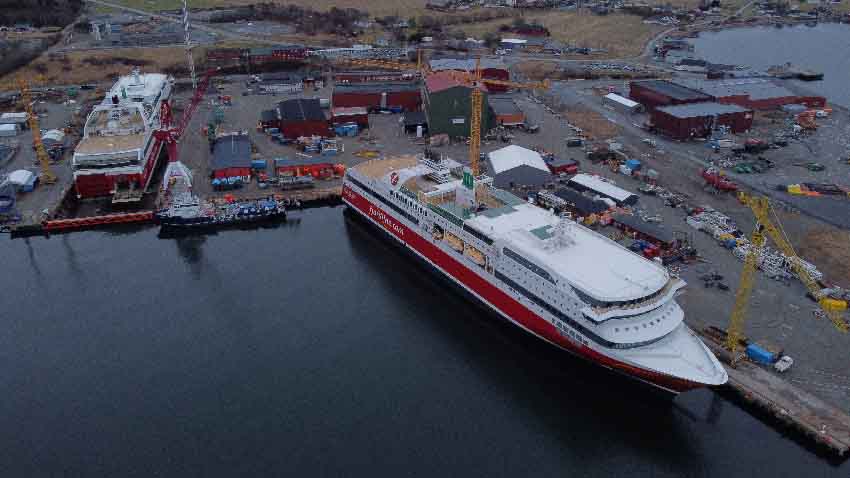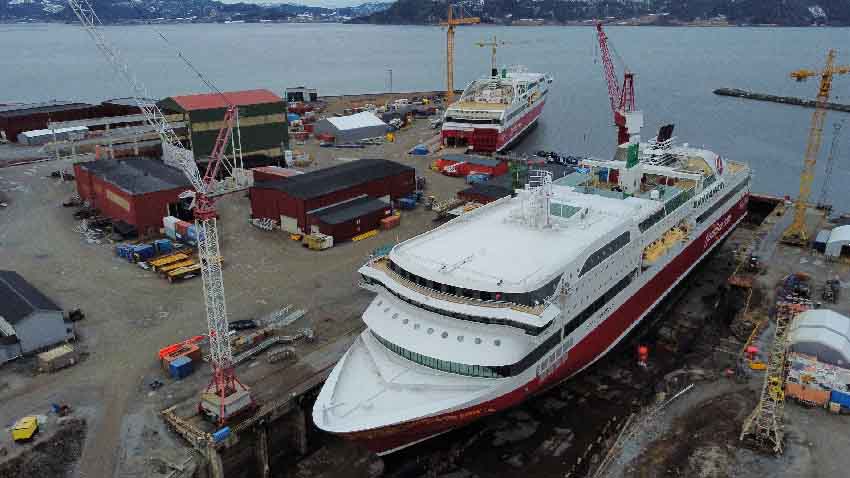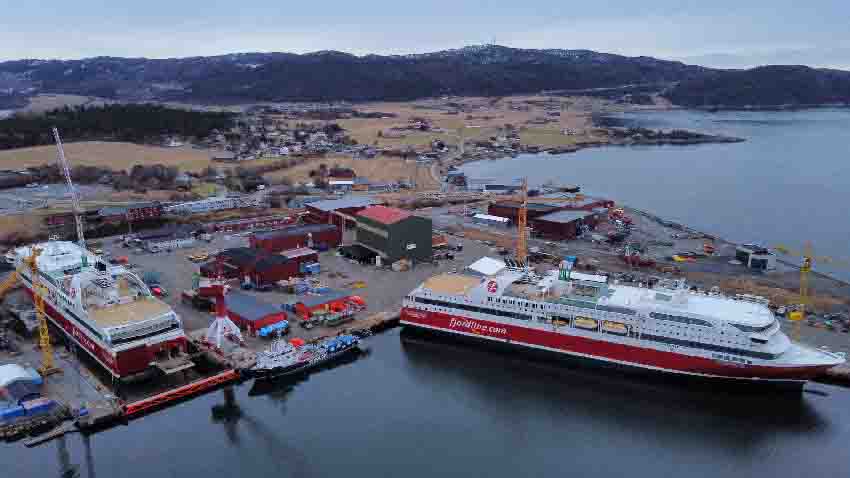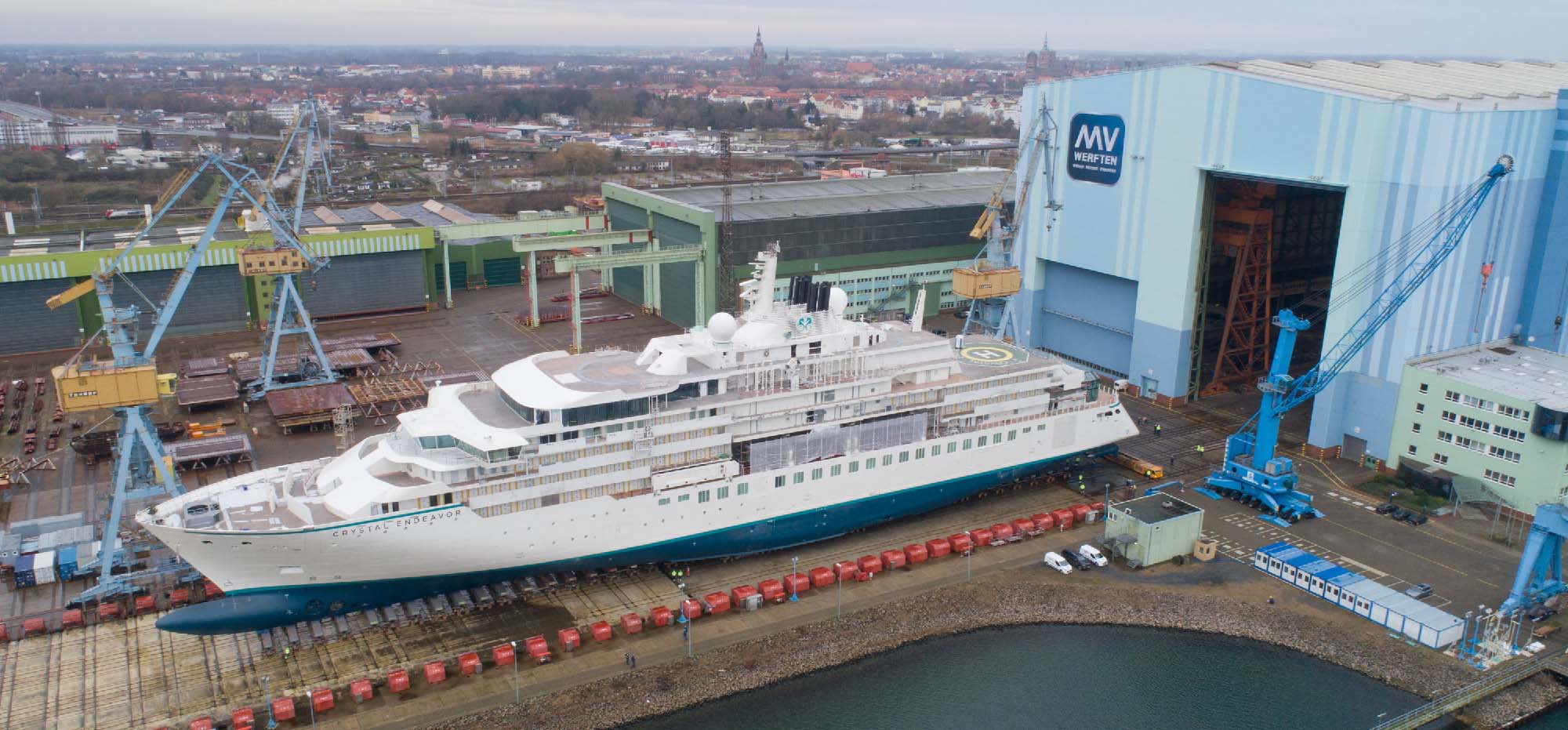With ship-building traditions dating back to 1918, Fosen Yard offers its customers workmanship based on a century worth of experience. They have continuously kept up with the changing markets and development of new production methods and technologies.
Their shipyard in Rissa has a large drydock (215 x 40 m) and two outfitting quays, in addition to a number of sheds and halls for production and processing of materials. The company also has accommodation and messrooms for 300 workers on site, that they utilize when they have a high workload. In the recent years, Fosen Yard’s main activity has been conversions of large passenger ferries and rebuilding of aquaculture vessels.
On 1 July 2022 Fosen Yard leased a large part of Volkswerft in Stralsund, which will be operated under the name Fosen Yard Stralsund GmbH. This yard has outstanding facilities, with a new-building hall of 300 x 108 m and one of the world’s largest ship lifts, with capacity of 25,000 tons and measuring 270 x 35 m. Their intention is to build smaller luxury cruise vessels there, in addition to doing conversions on RoPax, yachts and other tonnage.
Fosen Yard also has an in-house design and engineering company, Fosen Design & Solutions, which has a dedicated staff within the different disciplines required to make up a fully functional organization to handle both basic and detailed design, machinery, piping, HVAC, interior, electro, automation and hydrodynamics.
Fosen Group can offer a variety of services, providing years of knowledge and experience in creating excellence for ship owners and their charterers & customers.

Easy Engineering: What are the main areas of activity of the company?
Fosen Yard: For many years, Fosen Yard’s main business was building new vessels, primarily smaller cargo ships, before entering the market for larger RoPax and passenger vessels in 1990. In 2007 Fosen Yard joined the offshore boom and for the next years built larger subsea construction and seismic vessels, in addition to two passenger ferries for Fjordline.
With the collapse of the offshore segment in 2014, this market vanished overnight, and Fosen Yard shifted focus to larger refurbishment and rebuilding jobs on passenger ferries. Fosen Yard Rissa was awarded the task of replacing the complete interior on altogether nine of Hurtigruten’s vessels and have in the recent years also rebuilt several vessels for the aquaculture sector. Fosen Yard’s most famous project is “The World”, which was completed in March 2002 and is the largest private residential ship afloat.
Our lease of the yard facilities at former Volkswerft in Stralsund enables us to target the upper end of the market for boutique cruise vessels and also yachts, as the newbuilding hall there measures 300 x 108 m and the complete vessels can be built inside. We are currently in negotiations with several ship owners to build 150-200 pax luxury cruise vessels. The Crystal Endeavor (now Silver Endeavour) was delivered from this site in august 2021 and is considered one of the most luxurious cruise ships afloat.
With one of the world’s largest ship lifts just outside the newbuilding hall, we are also positioned to execute vessel lengthening and docking of vessels up to 25,000 tons. In February, FRS high-speed passenger catamaran Skane Jet was lifted on this for a scheduled docking.

E.E: What’s the news about new products?
Fosen Yard: Fosen Yard doesn’t sell products, but rather expertise and experience to meet a shipowner’s demands. In this regard, we do our utmost to be updated on the latest developments within battery technologies and the various new and environment friendly fuels being considered for both new buildings and machinery upgrades. We recently electrified and Norwegian double-ended ferry and have another coming in for the same conversion just after the summer holidays.
Our design company, Fosen Design & Solutions, is constantly challenging suppliers to offer the most compact and energy efficient solutions for their projects.
E.E:What are the ranges of products?
Fosen Yard: We offer assistance in all stages of design and development through FDS and both refurbishments, conversions and new-building capacity at our two yards.
E.E: At what stage is the market where you are currently active?
Fosen Yard: The market for smaller luxury cruise vessels and expedition ships is still quite hot and expected to remain so for some time ahead.
An ever-increasing market is that for offshore wind, where CSOV/SOVs, installation vessels, cable layers and very large anchor handlers will be in high demand for the years to come. This prediction is based on the number of planned and contracted windfarms world-wide.
Fosen Yard is positioned to build vessels in both these segments.

E.E: What can you tell us about market trends?
Fosen Yard: Overall there will be a continuous strive towards more energy-efficient vessels and solutions to meet the various requirements to reduce emission from shipping. However, the industry complains the target of IMO to reduce these by 40% by 2030 will be very challenging, primarily because most of the solutions for alternative (green) fuels are yet not mature and the availability of them very questionable in other geographical areas than the main shipping lanes. So there will be a lot of turmoil ahead before the technology and fuel supplies are available to meet demands.
E.E: What are the most innovative products marketed?
Fosen Yard: There is at present a demand for greener, safer, smarter, and more efficient solutions in the maritime sector and thus, suppliers all along the chain are striving to obtain these measures. Often collaboration between suppliers is required to reach certain goals. But one of the most effective ways of doing this is digitalisation – ensuring safe data collection from ships and utilising this to improve the performance, training, risk assessment, design, etc., e.g. by making a digital twin of a vessel.
A lot of R&D is presently being done to make larger and more efficient fuel cells, multi-fuel engines and heat-recovery systems, lighter and more energy dense batteries and, not least, more efficient hull designs and propulsion systems. All to save fuel and reduce emissions.
Artificial intelligence (AI) and autonomous operations will also be further developed and utilised more in the maritime sector, which will reduce the amount of human error and result in safer operations.

E.E: What estimations do you have for 2023?
Fosen Yard: For the yard sector, I predict we will se a surge of projects for the offshore wind segment.
Inevitably, the offshore market will have to renew their tonnage, as there has hardly been built vessels in this segment since 2014. An aging fleet, with numerous vessels being cold-stacked and in too poor condition to re-enter the market, new regulations and requirements regarding emissions and freight of chemicals, will force new-buildings to meet demand. The biggest obstacles at present are the reluctance from banks to finance such tonnage and the charterers reluctance to award longer contracts. The latter is one of the reasons for the former. But this will probable change soon, or the market will find itself without available tonnage.
I also expect a number of RoPax vessels being upgraded to meet new requirements and to prolong the life of these, as the COVID pandemic has effectively stripped RoPax owners of their cash reserves and thus, many can’t afford to build new vessels.

